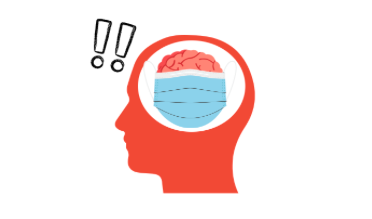TW: This article contains mentions of anxiety, self-injury, and disordered eating
Fever, cough, body aches, nausea, loss of taste or smell.
Many of us have experienced these physical symptoms of Covid-19 first-hand or know someone who has. They appear on our daily screeners, on posters outside of restaurants and other public buildings, and on healthcare websites like WebMD.
The non-physical “symptoms,” while equally important, are less publicized. The pandemic has had drastic effects on mental health, especially anxiety.
Since the onset of the pandemic in March 2020, 1 in 3 teen girls and 1 in 5 teen boys have reported new or worsened anxiety.
“During lockdown, my anxiety got very bad,” said sophomore Mia Divalerio. “I had so much time on my hands for overthinking, leading me to be in a constant state of panic.”
Quarantine didn’t just leave students alone. It left them alone with their negative thoughts and anxiety, without resources for support.
“The number one most common resource for students struggling with anxiety is the small contacts with people who care about them,” said social worker Mr. Daniel Maigler. “The teacher asking them about their new haircut, friends trying to ship their favorite anime characters … all these resources went missing for many months.”
Maigler and other social workers rely heavily on in-person interactions in the classroom to identify students who are hurting.
“[Teachers] notice something has changed in that person’s posture or engagement and ask me to check on them,” he said. “I shudder to think of how many kids we have missed who did not have the energy or confidence to ask for help because no one noticed their struggles.”
In a vicious cycle, the pandemic worsened anxiety for students, and on top of that, limited access to healthy coping mechanisms.
“It took away sports, being able to see my friends everyday, and working out in groups, which are all things that help me manage my anxiety,” said sophomore Mariella Haubner.
As a result, desperate teenagers may have turned to maladaptive coping strategies.
“People tend to turn to unhealthy coping skills like self-injury, disordered eating, risk-taking behaviors, and alcohol and drugs because these things change the way we feel quickly,” said Maigler.
These distractions, which may numb anxiety short-term, can also desensitize us to the joys of life.
“When the positive feeling is gone, we have to go back and deal with the stress of life,” he said. “A person faces the choice between stepping into the pain or staying numb all the time.”
A person faces the choice between stepping into the pain or staying numb all the time.
— Dan Maigler
Maigler recommends that students find productive ways to express their feelings through discussion, journaling, poetry, or art. Breathing exercises, which are available on an app called Headspace, may also help teens relax.
As COVID restrictions loosen up, students can regain increased access to friends, teachers, sports, and extracurriculars. While this sharp transition may have improved anxiety symptoms for some, it triggered social anxiety for others.
“After the pandemic, since I had been out of the social scene for so long, my social anxiety worsened,” said junior Lauren Atchley. “Throughout quarantine I was only communicating with my closest friends, so when quarantine ended, I was unsure about how to act around different people.”
If you or a peer struggle with anxiety, you can email your social worker for support.
“If you are not sure which one is the right social worker for you or a friend go ahead and email all three of us and we will work it out, no extra charge,” said Maigler.
This story was originally published on The Forest Scout on April 26, 2021.






























![IN THE SPOTLIGHT: Junior Zalie Mann performs “I Love to Cry at Weddings,” an ensemble piece from the fall musical Sweet Charity, to prospective students during the Fine Arts Showcase on Wednesday, Nov. 8. The showcase is a compilation of performances and demonstrations from each fine arts strand offered at McCallum. This show is put on so that prospective students can see if they are interested in joining an academy or major.
Sweet Charity originally ran the weekends of Sept. 28 and Oct. 8, but made a comeback for the Fine Arts Showcase.
“[Being at the front in the spotlight] is my favorite part of the whole dance, so I was super happy to be on stage performing and smiling at the audience,” Mann said.
Mann performed in both the musical theatre performance and dance excerpt “Ethereal,” a contemporary piece choreographed by the new dance director Terrance Carson, in the showcase. With also being a dance ambassador, Mann got to talk about what MAC dance is, her experience and answer any questions the aspiring arts majors and their parents may have.
Caption by Maya Tackett.](https://bestofsno.com/wp-content/uploads/2024/02/53321803427_47cd17fe70_o-1-1200x800.jpg)
![SPREADING THE JOY: Sophomore Chim Becker poses with sophomores Cozbi Sims and Lou Davidson while manning a table at the Hispanic Heritage treat day during lunch of Sept 28. Becker is a part of the students of color alliance, who put together the activity to raise money for their club.
“It [the stand] was really fun because McCallum has a lot of latino kids,” Becker said. “And I think it was nice that I could share the stuff that I usually just have at home with people who have never tried it before.”
Becker recognizes the importance of celebrating Hispanic heritage at Mac.
“I think its important to celebrate,” Becker said. “Because our culture is awesome and super cool, and everybody should be able to learn about other cultures of the world.”
Caption by JoJo Barnard.](https://bestofsno.com/wp-content/uploads/2024/01/53221601352_4127a81c41_o-1200x675.jpg)






